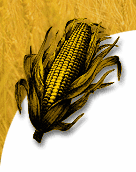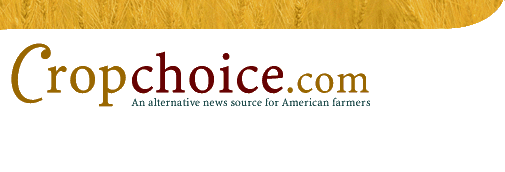

  |
|
|
Cloned food products near reality (Wednesday, Sept. 18, 2002 -- CropChoice news) --
Justin Gillis, Washington Post, 09/16/2002:
Milk from cloned cows and meat from the offspring of cloned cows and pigs
could show up on grocery shelves as early as next year under the plans of
livestock breeders who are already raising scores of clones on American
farmsteads.
A recent report from the National Academy of Sciences, the nation's top
scientific body, has given fresh impetus to the effort to turn cloning into
a routine tool of U.S. agricultural production.
A special NAS panel that reviewed developments in animal biotechnology was
alarmed by genetic manipulation of fish and insects that might escape and
harm wild species, but it found cloning of farm animals less troublesome,
since the technique involves copying adult animals without altering their
genes. The committee called for a few additional studies but said the
technique was unlikely to affect the safety of the food supply.
"I think our message was fairly loud and clear," said panel member Eric
Hallerman, a biologist at Virginia Polytechnic Institute and State
University in Blacksburg. "The concern about food safety, we thought, was
just way overblown."
A few cloned cows scattered around the country are already producing milk.
Farmers and companies have held off selling it only because of informal
requests from the Food and Drug Administration, which is reviewing whether
clones, their byproducts or their offspring should be allowed into the food
supply.
The agency hopes for a decision by late this year. Absent compelling
evidence of a problem, it's not clear the FDA or any other government agency
would have the legal power to keep cloned animals out of the food supply.
The biggest lingering concern appears to be for the welfare of cloned
animals and their surrogate mothers, with some groups saying the development
of cloning on a large scale will lead to widespread animal suffering.
The number of cloned animals living on American farms today is small -- most
estimates put it at fewer than 100. All are elite animals that cost tens of
thousands of dollars to produce and are valued as breeding stock, not as
meat.
For that reason, products made from clones are likely to be a mere trickle
in the marketplace, at least at first, farmers said. But if the technique
becomes established and the price of cloning falls, farmers envision a day
when entire dairy herds may be stocked with nothing but clones of the most
prolific cows.
The technique may never be cheap enough to produce animals for use directly
as meat, but breeders said it's likely the first- or second-generation
offspring of clones will wind up in the meat supply in large numbers.
The cloned food products that could hit the market in small quantities next
year include milk from cloned Holstein dairy cows and, potentially, veal
from their first-generation offspring. Pigs would likely not be far behind,
with some first-generation offspring probably being butchered for food in
2004 or 2005, animal breeders said.
Other countries are moving in the same direction as the United States. A
study published recently in Japan said cloned meat and milk are identical to
the ordinary kind. That nation is now preparing to lift a ban.
A handful of American animal breeders plunged into cloning two years ago,
mindful that no law or regulation said they couldn't, and they were caught
off guard by the informal FDA moratorium that followed. They said they had
been trying to honor the agency's ban, but economic pressures are mounting
as the animals reach their prime reproductive years and they need to recoup
investments that typically exceed $20,000 per clone.
"There is a certain level of anxiety out there, waiting for us to make a
decision," said Stephen Sundlof, director of the FDA's Center for Veterinary
Medicine, who is leading the agency's review.
An elite Holstein dairy cow typically proves her worth in the second and
third years of life, when she bears a calf, begins lactating and establishes
a record of milk production.
Once a champion establishes her résumé, her real value is in her embryos,
which can sell for as much as $2,500 apiece for transfer into surrogate
mothers. But the cloned Holsteins now reaching sexual maturity won't get to
that point unless they are allowed to bear calves and start making milk.
Some cloning companies are already pouring out milk from clones. By this
spring, farmers in scattered spots around the country will face the choice
of selling milk from their clones or dumping it back on their fields. If the
FDA will let them, they plan to sell it.
Greg Wiles, proprietor of a dairy farm in Williamsport, Md., knows the
pressures firsthand. His family once owned the top-ranked Holstein in the
country -- Con Acres HS Zita-ET, registered Holstein No. 14411844. Zita,
worth as much as $150,000 in her prime, died last year -- but not before
Wiles, with help from a company in Massachusetts, spent some $70,000 to
create two clones, Genesis and Cyagra.
They are healthy animals who have reached sexual maturity, Wiles said, and
he has already used embryos from the clones to produce seven new pregnancies
by embryo transfer to recipient cows.
Wiles said he needs to establish pregnancies soon in the clones themselves.
That will not only let them build milk-production records, it will also help
them keep producing embryos at a high level in their mature years. The
clones and their female offspring, if they are anything like Zita herself,
should be fantastic milk producers, Wiles said.
"We are probably getting a little ahead of the FDA," Wiles said. "I have
always stood behind the fact that we knew we weren't genetically altering
anything with the cloning process. There was a lot of newness when the
clones were born, but they've really become just like any other cow on the
farm."
Even breeders who have not yet embraced cloning are preparing for the day it
becomes routine, paying several hundred dollars to freeze cells from elite
animals that could eventually be used to make clones. Some have learned the
technology can salvage the genes of some animals that have already died.
Jon Fisher, owner of Prairie State Semen Inc. of Champaign, Ill., paid a
then-record $43,000 in 1997 for a beautiful Hampshire boar at an auction in
Texas. "I thought he was the best animal I had ever laid my eyes on," Fisher
said.
It was a smart call: Fisher's business is selling semen from champion boars
to breeders who produce the long, svelte pigs that dominate 4-H and Future
Farmers of America livestock competitions. The new animal, much in demand,
greatly elevated Fisher's reputation in the world of pig breeders. He named
the boar 401-K, after the retirement account.
A year ago Fisher was getting ready to have 401-K cloned when the animal
died suddenly of an intestinal blockage. The boar had been dead several
hours by the time Fisher managed to salvage ear cells and ship them off to
Infigen Inc. of DeForest, Wis., one of a handful of American companies
offering cloning services to breeders. "It was like a bad Woody Allen movie,
the way we were running around here," Fisher said.
But it worked: Fisher now has six clones of 401-K and one of The Man,
another champion boar. "They look like a pig. They smell like a pig. They
feel like a pig," Fisher said. "It's a pig."
The clones have now reached sexual maturity, and he has been taking orders
for semen, held back from shipping only by the FDA's informal request. Boar
semen doesn't store well, and Fisher said he's losing money for every week
the agency's deliberations drag on.
"We've been caught off guard here," Fisher said. "For the good of the
industry and the good of consumer confidence, I guess I'm not opposed to
waiting. But if this drags on and there's [no prohibition] in writing, I'm
going to sell semen."
Some pig-show contestants wind up as breeding stock themselves, but most are
eventually butchered, so some offspring of Fisher's clones are likely to
wind up in the food supply. Likewise, beef-cattle producers are expected to
use clones to upgrade the genetics of their herds, with first- or
second-generation offspring of clones eventually being sold for meat.
Sundlof, the FDA administrator, said his agency was working hard to produce
a draft report by year-end. But he said that report would need to be
reviewed at the upper echelons of the Bush administration, so the FDA can
make no firm commitment to breeders about timing.
In theory, cloned animals, made by essentially the same technique that was
used to produce Dolly the sheep in 1996, are close genetic copies of their
adult progenitors, and in theory, eating them shouldn't pose any special
concern to a person who would have eaten the original.
But it's fuzzier than that: Research indicates that cloning alters some
genetic patterns, at least slightly, and there's a small scientific
possibility that this could affect the resulting meat or milk. Preliminary
comparisons have suggested there's little cause for worry, but the FDA is
awaiting more definitive data.
Scientists said offspring present no risk because they are the product of
natural sexual crosses. "The offspring of clones we're not concerned about
at all," said Hallerman, the expert from Virginia Tech. "That's just a
normal animal."
One concern for the FDA is that breeders going to the expense of cloning may
also attempt genetic modification of the animals, perhaps to make them
leaner or improve milk production. Such genetic manipulation poses far more
potential problems than mere cloning does, and the FDA would likely require
extensive proof that the gene-altered animals are safe to eat.
"Once you get into the cloning technology, it's very tempting to want to
manipulate a few genes here and there, too," Sundlof said.
The commercial market for cloning remains unsettled. Infigen has returned
some clones to American farms but had to destroy other animals to cope with
financial problems. Cyagra Inc. of Worcester, Mass., continues to offer
cloning services to breeders (it produced Greg Wiles's clones, which is why
he named one Cyagra), and other companies are expected to jump into the
market if the FDA clears the way.
The biggest remaining concern is animal welfare. Though clones that survive
to adulthood typically seem healthy, they die in inordinate numbers in the
womb or just after birth, and the pregnancies appear to be stressful for the
surrogate mothers.
Concern about animal suffering is not confined to the most assertive
animal-rights groups. The NAS panel raised it as a serious issue, and
mainstream groups like the Humane Society of the United States are also
alarmed.
"We are deeply disturbed by the idea of mass cloning by the industrial
agriculture industry," said Wayne Pacelle, senior vice president of the
Humane Society. "It will accelerate the drive toward factory farming, which
is already becoming dominant."
Industry advocates respond that cloning is still in its early days, and they
aim to reduce the failure rate -- and thus, the potential for suffering.
They predict a gradual acceptance.
"This is so new and so revolutionary that the educational process is a huge
task," said Ron Gillespie, vice president of marketing for Cyagra. "People
still don't understand the technology, but we're finding more and more
takers."
http://www.washingtonpost.com/wp-dyn/articles/A22061-2002Sep15.html
| |